Theme 1: What is Strategy?
We use the word ‘strategy’ to mean the longer-term framework that guides a change effort, but it can also describe the specific actions, tactics, and processes used in the shorter term. This may be a bit confusing. Find the words that make sense to you in your language and political culture to distinguish a big picture strategy from a more immediate or focused one.
Activists and organisations facing huge external pressures tend to focus on immediate, short-term priorities and routine approaches to planning. They don’t always stop to critically reflect on the context, the histories they build upon, their assumptions about how change happens, and what they can do to achieve it over the long-term.
Everything in this Guide so far has prepared us to construct strategies that navigate, build, and transform power for social justice. Strategy comes together by connecting all the strands of analysis, visioning, and prioritising.
Not everyone using this Guide will work in a direct movement-building role, but we can all locate our actions within the broader movement ecosystem in which our organisations, strategies and agendas sit, and identify ways to connect, align, coordinate, and build movement power, connections, and infrastructure.
Activity 1: Components of a movement strategy
Activity 1: Components of a movement strategy
Materials: Flipchart paper, sticky notes, pens, handout: Strategy components
Plenary: Introduce the activity. Share the handout: Strategy Components. Introduce each component and ask people to recall key insights and ‘aha’ moments from earlier sessions. Prompt with examples from the analysis and insights they have generated so far, or invite them to reflect on these questions now.
Individually: Invite people to look at the questions on the handout and jot down any key insights. Ask them to choose three key insights and write them on sticky notes.
Plenary: For each component, people take turns to post their sticky notes on the flipcharts or slides, reading out and explaining each one. When one component is done, review the notes and ask:
- Is anything missing here?
- Does anything stand out?
- How does this component contribute to shaping strategy?
Download this activity.
Strategy components
Movement strategy depends upon organising and groundwork around the five key components in the table below.
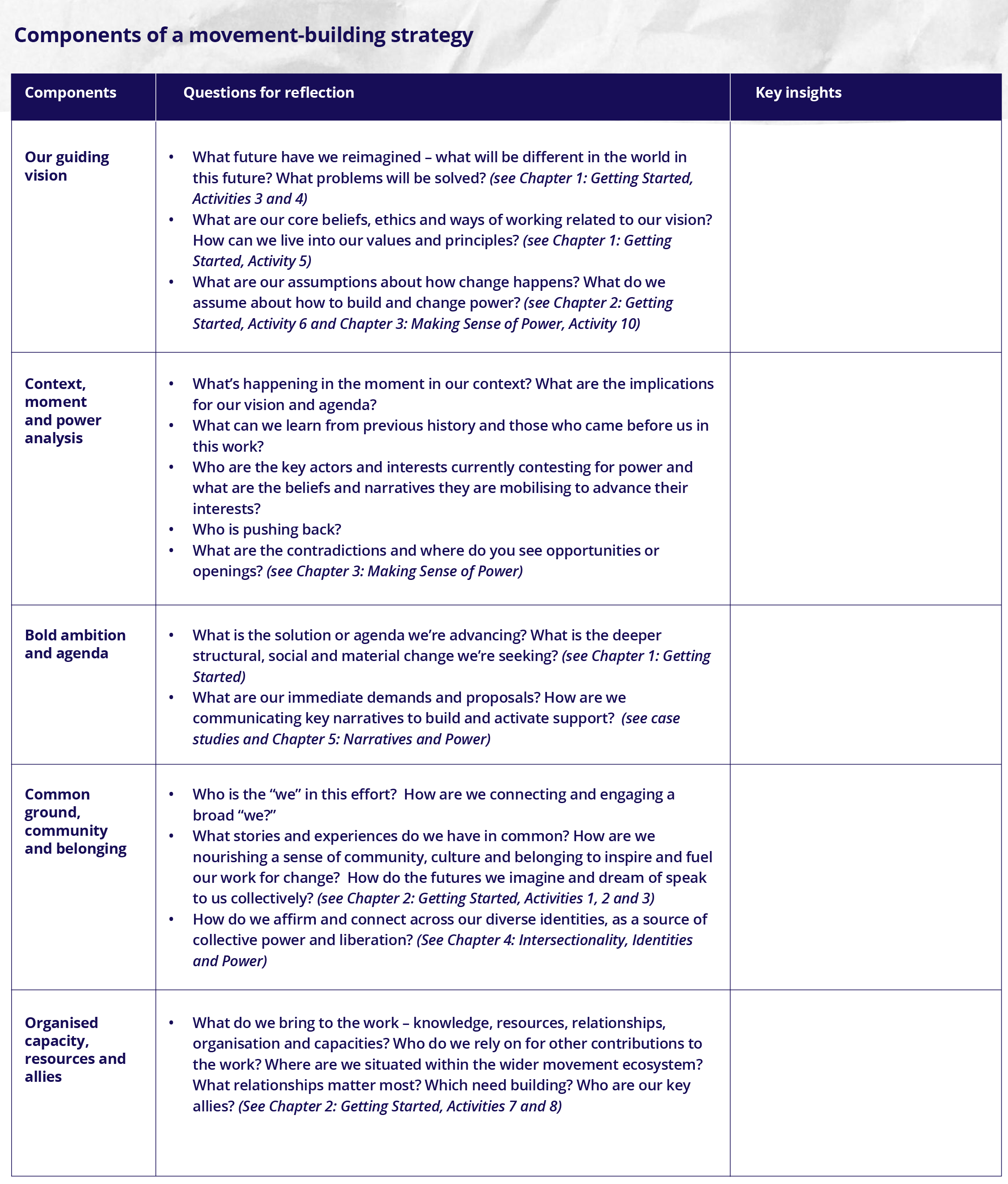
Download handout: Strategy components.
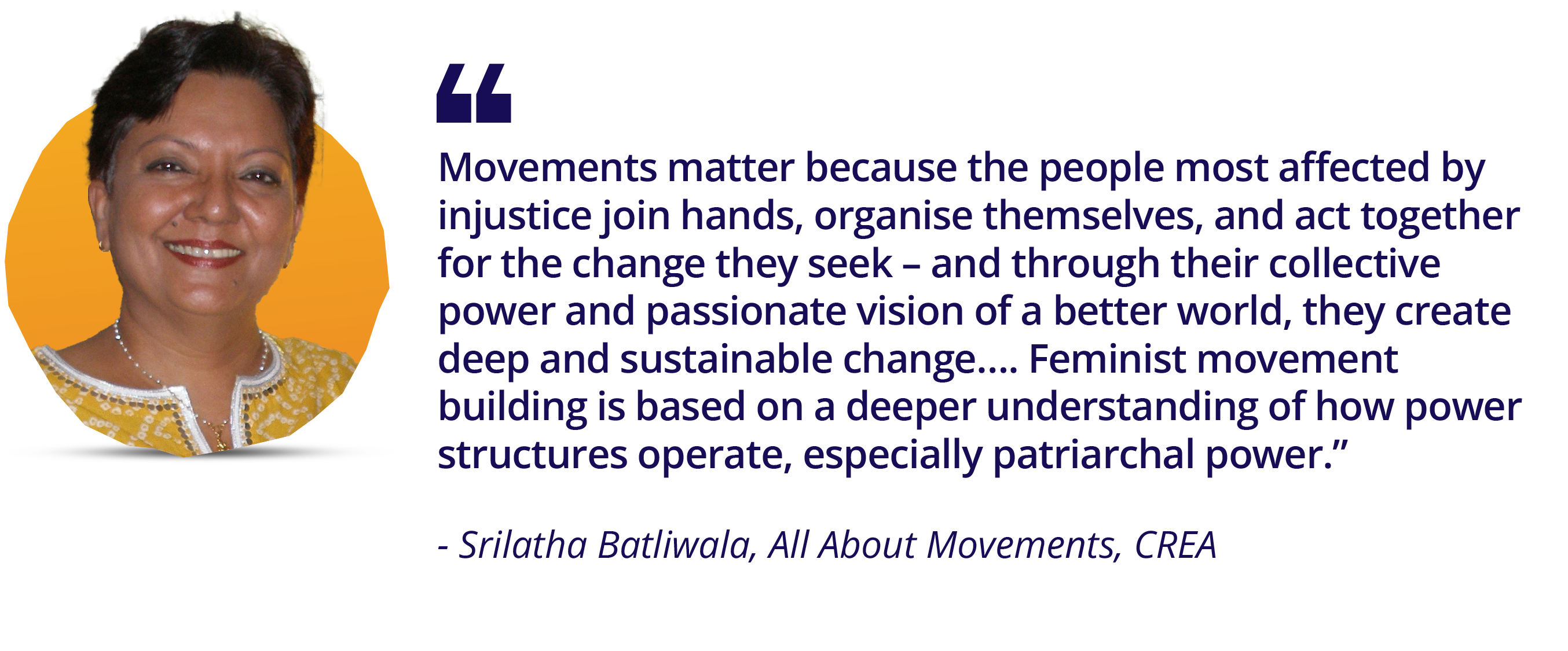
Activity 2: Strategy for movement-building
Activity 2: Strategy for movement-building
Materials: Virtual equivalents; notes or outputs from Chapter 1: Getting Started, Activity 5: Living into our visions and values, and Activity 7: Movements and Movement-Building, including copies of the Handout: Movements and movement-building.
Make, print, or share a large copy of the graphic Components of a movement-building strategy
Plenary: Display the resources and outputs from Chapter 1: Getting Started (if you worked on this). Introduce the activity with the ideas that open this chapter and section, adapting them to people’s specific context and issues.
Individually: Invite people to reflect on their personal experiences of strategy and movement-building – whether through direct involvement or observation of a movement and strategies they are familiar with. Then jot down brief answers:
- What in your experience is ‘strategy’?
- What kinds of strategies have you been part of, or what strategies have you seen other social change efforts use? What do you feel worked well and not so well?
- What do you see as five key components needed to create an effective strategy, one that contributes to movement building?
Write your five key points on sticky notes. Focus on key components, rather than the strategies themselves.
Plenary: Display a large version of the graphic Components of a movement strategy. Invite each person to place their sticky notes one by one on the graphic, on or near the most relevant component. When everyone has shared, open a discussion.
- What has this group identified as the most important components?
- What are other key elements for developing a movement strategy in your view?
- What do these different strategies contribute to making change and how can they be complementary?
Download this activity.
Movement ecosystem
A movement-building strategy inevitably combines different tactics, processes, and actions carried out by different organisations and entities, rather than a singular plan from a single group. These organisations play different roles and make distinct strategic contributions in the broader movement ecosystem, particularly if they are more or less aligned and connected. No single organisation pursues all of the strategies necessary, but together, with intention, they can become a powerful force for change. Different actors play diverse but ideally complementary roles so that the whole is greater than the sum of the parts. We need to locate our organisational and individual positioning and contributions in the broader ecosystem and identify potential alliances and alignment with others pursuing complementary strategies.
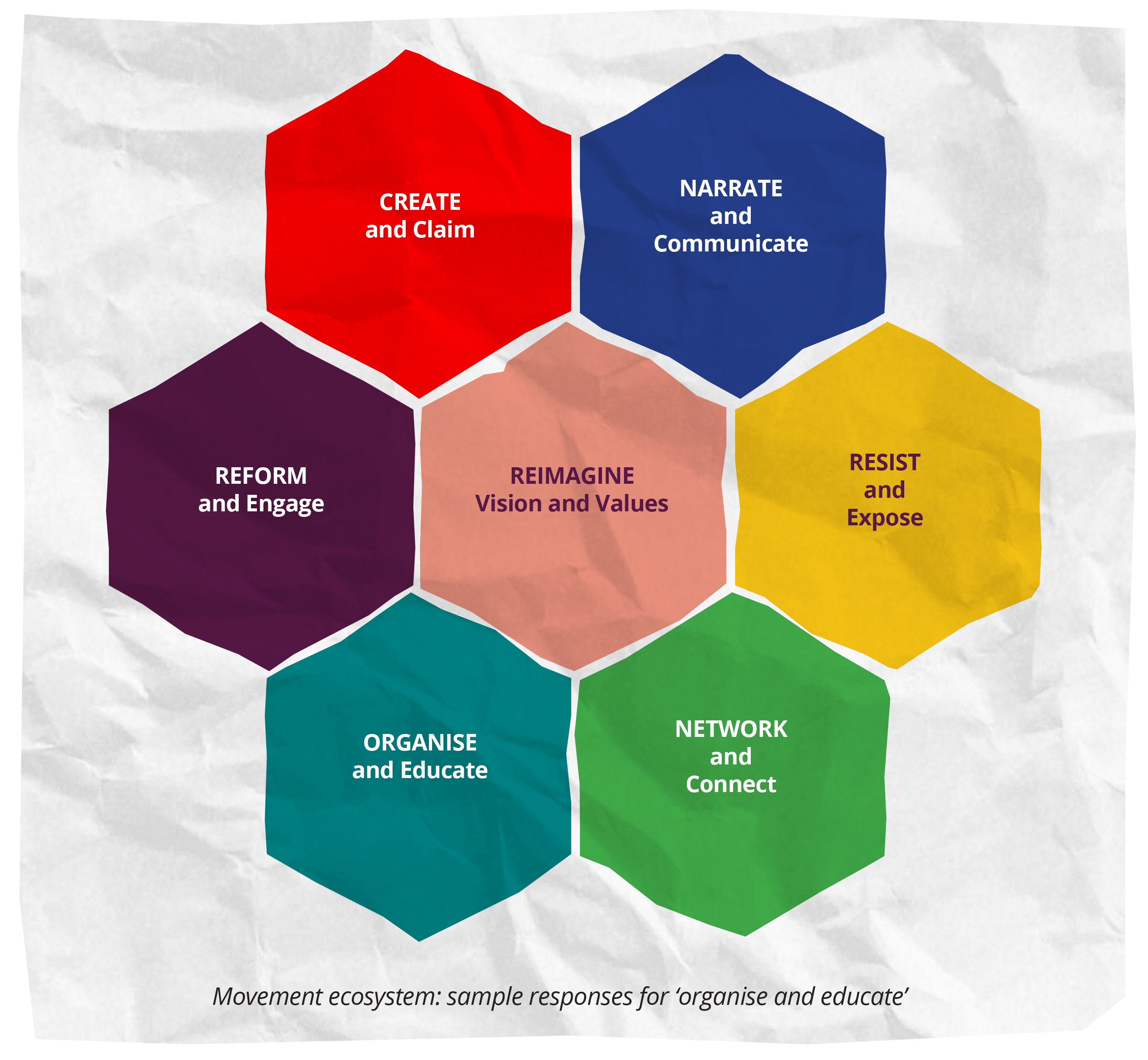
Activity 3: Movement ecosystem: sample responses for ‘organise and educate’
Activity 3: Movement ecosystem: sample responses for ‘organise and educate’
Materials: Display a large copy of A movement ecosystem, and provide copies as a handout; flipchart paper, six large strategy cards for each work table. Plus, for Step 2, dot stickers of different colours
Plenary: Refer to the definition of strategy:
- Strategy is a collaborative process that guides people, organisations and movements towards achieving systemic, structural, and material change for justice and belonging.
- Any strategy includes short- and medium-term actions in pursuit of long-term goals. A movement-building strategy specifies how organising, leadership-development, alliances and joint action build capacity over time to advance the values and vision. In a context of constant flux, think of strategy as the compass that orients decision-making and informs short-, medium-, and long-term actions and processes.
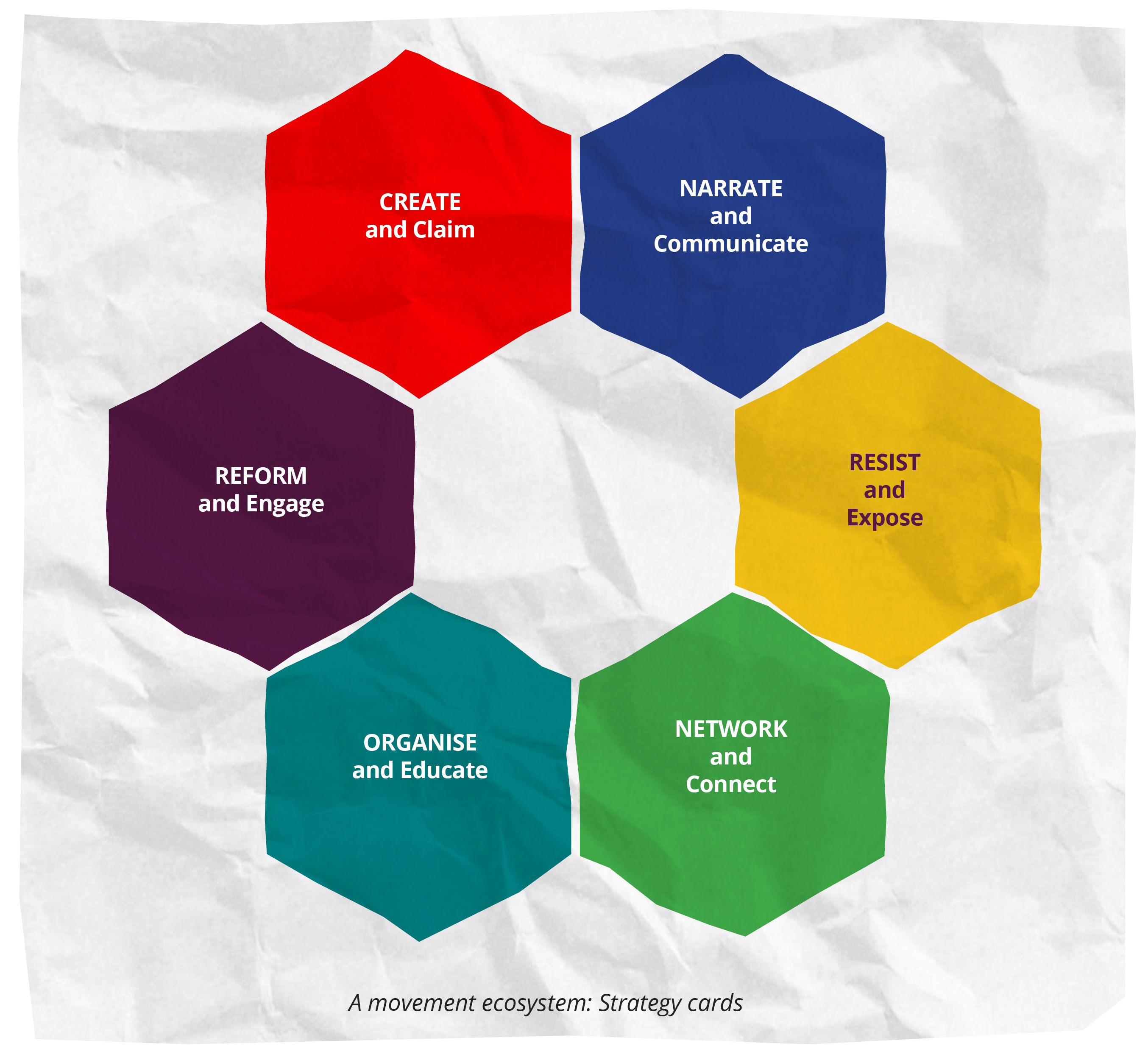
Step 1: World café
Plenary: Place one of the six strategy cards on each of six work tables. Invite people to group themselves by strategy, ensuring equal numbers per table.
Small groups: Each group appoints a note-taker who stays at the same table. The rest of the group moves from one table to another for three rounds of 10 to 15 minutes per round. At each table, the group discusses:
- WHAT does this strategy accomplish in relation to building and changing power?
- WHY is this strategy critical in relation to the others and for achieving change?
- HOW is this strategy carried out? What does it look like in practice?
- WHEN is this strategy most useful?
- WHO should be involved and how?
- WHERE is this strategy used?
The note-taker summarises the first round and adds new points from subsequent rounds.
Plenary: The whole group moves together from one table to the next. Each note-taker summarises the key points from that table.

Step 2: Where are we in the movement ecosystem?
The Movement Ecosystem helps us to situate our organisations and our change strategies in a given context and moment in time, and in relation to the many other different actors, groups, and forms of activism and influence that contribute to the change we are seeking. No single organisation or activist can do every strategy, so the ecosystem guides us to think about our identity, niche, and strengths along with the possible gaps in our strategy and alignment, and to consider where we can build alliances and coordinate better.
Plenary: Hand out three different colours of dot stickers to each person (or use three colours of markers to draw dots). Thinking about the identified strategies, and allowing for overlap:
- Place a dot of one colour on the strategies you are most engaged with (use more than one dot if you work in more than one area).
- Place a dot of the second colour on areas where allies or others you know are engaged.
- Place a dot of the third colour areas where there seem to be gaps, or where you may need to stretch or adopt strategies.
Review the results and ask:
- What are your main assets, resources and areas of strategic focus?
- In what areas are others working? Who are they and what are they doing?
- With whom are you in relationship or alliance? With whom are you not connected?
- Where are the gaps or areas you (or others) may need to stretch into?
- Where do you need to build capacities, relationships, and alliances to move your agenda forward?
Use lines to connect the groups and efforts where relationships and alignment can be strengthened or developed; a dotted line for areas of coordination and a solid line to show formal alliances or collaboration to develop.
Download this activity.
Alignment and infrastructure
Alliances vs alignment: It is not always necessary or possible to build relationships or alliances with all actors across a movement ecosystem but it can be beneficial to have a greater awareness about who is doing what and how best to coordinate, even without direct collaboration.
Lack of alignment is a major weakness among NGOs and across movements. The movement ecosystem tool and process invite orientation and alignment across different strategies in a way that potentially strengthens connection and movement infrastructure.
Timing shapes the opportunities for strengthening infrastructure across the ecosystem. In crises and when injustices and repression are extreme, often the energy to connect, unify, and build power is greater. These are important moments to invest in organising.
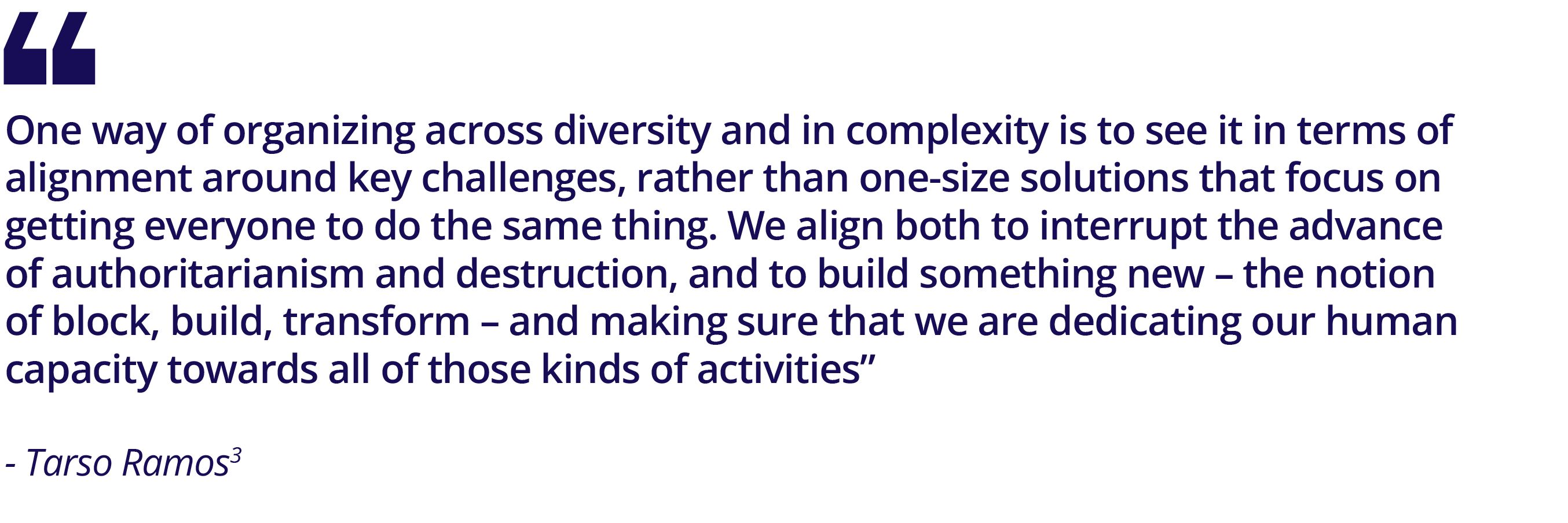
______________________________
3 Executive Director of Political Action Research, researcher and strategist on confronting rising authoritarianism, quoted in JASS Dialogue What Time is it on the Clock of the World, May 2023
